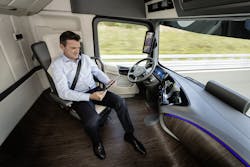Self-driving trucks: How the road ahead may shape up
Proponents of so-called “self-driving trucks” contend that their enabling technologies will work in concert to cut fuel consumption, reduce emissions and ensure highway safety much more effectively than today’s commercial vehicles.
Trucks engineered with various levels of self-driving technology are expected will start pulling onto North American roads over the next decade. And it’s predicted that eventually, perhaps around 2025 or later, that fully autonomous— that is truly driverless— trucks will be rolled out.
Sandeep Kar, global director-- Automotive & Transportation Research for Frost & Sullivan, has provided FleetOwner with forward-looking perspective on how this brave new world of trucking may play out down the road “based on preliminary baseline research my team has conducted thus far.”
Regarding claims that self-driving trucks will be more fuel-efficient, Kar said “Trucks that will host these technologies in 2020 and beyond will be more fuel-efficient compared to trucks today and will feature even higher levels of distributed electronics.
“Automated vehicle technologies can enhance fuel efficiency by communicating with disparate vehicle systems and sub-systems in trucks featuring electronic interfaces,” he continued. “Moreover, OEMs will design and use these technologies to catalyze highest fuel efficiency so as to influence the purchase decision of truck buyers.”
Kar noted that wireless platooning is “a form of autonomous driving that has shown meaningful fuel cost savings with very little incremental increase to a truck's price. That can be leveraged by long-haul fleets to derive significant cost savings. This is one of the autonomous driving technologies/concepts that if applied properly can deliver interesting fuel economy gains.”
According to Kar, self-driving trucks will improve the performance of individual truck drivers “particularly if drivers can extract the promised benefits of this technology effectively and efficiently-- which includes higher fuel efficiency, higher safety, less driver fatigue, etc.
“Nowadays,” he pointed out, “more and more fleets are incentivizing drivers for safe driving, and this technology can help drivers with safe driving, regulation compliance and fatigue reduction.”
While Kar conceded that “the jury is still out” on the technology’s potential to improve highway safety, he said that “our initial research indicates that highway safety may actually increase overall since most accidents can be attributed to human error and driver drowsiness/fatigue.
“However, this will be a long-term phenomenon,” he continued, “since it will take at least a decade or more from 2025 onwards to have a sizeable population of such vehicles on the road to make a meaningful impact on highway safety. As significant volumes of such trucks start running in our highways, enabled by vehicle-to- vehicle [V2V] and vehicle-to-infrastructure [V2I] communications, highway safety will likely improve.”
Kar also advised that self-driving technology “would also enable drivers and vehicles to communicate more effectively with shippers, receivers, fleet hub, and service and maintenance infrastructure. That would improve overall mobile-resource productivity.
“The foundations of freight-vehicle-freight connectivity are being laid here in North America as we speak and this [self-driving] business model and its applicability is highly scalable,” he continued. “Future connectivity technologies will link trucks to freight and freight to trucks in ways that will change the dynamics of freight logistics.”
Kar contends that “mission- and time-critical connectivity between freight and trucks will be the need of the hour in 2020 and beyond. This will reduce empty miles considerably and also maximize fleet uptime and equipment utilization rates. In such an environment, not just fuel efficiency but freight efficiency in North America could benefit from this technology as well.”
Kar expects self-driving technology will prove helpful for retaining drivers. “The health, wellness and well-being of drivers is already becoming a major focal point for all major global truck OEMs. This coupled with lightening the work load [via self-driving technology] will help retain drivers who fit the 40 years plus age demographic segment-- as these drivers are getting more interested in health, wellness, and wellbeing. This will also help retain younger drivers, whose need for connectivity and infotainment can be satiated during the time the vehicle is in autonomous driving mode.”
As for self-driving technology deepening the labor pool for truck drivers, he says that won’t happen anytime soon. “At the moment drivers require a CDL and we believe that Level 3 self-driving technology [driver in driver's seat with truck autonomously driven at certain times] will still require a CDl driver.” to be CDL qualified.
On the other hand, according to Kar, once Level 4 autonomous technology [no driver required] is available, it may be embraced for certain applications, such as over dedicated routes. “However,” he advised, “over the next five to ten years, the focus will be on adaptive cruise control technology and platooning and then by 2020-2025, the focus will be on Level 3 technology.”
Kar also pointed out that it will be crucial for truck makers to address the impact self-driving trucks might have on what they pay drivers. “If the driver is still there and is being paid a full salary, why would a fleet pay a significant price premium to acquire such trucks?”
Editor’s Note: Our January print edition will feature exclusive and in-depth coverage of “The Road to the Self-Driving Truck.”
